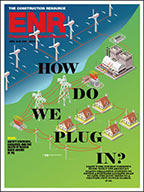 |
| ASCE's Headland, left, and Yin at site where wave claimed 1,500 lives. (Photo courtesy of ASCE) |
Editor's note: Late last month, the American Society of Civil Engineers sent three teams to the tsunami disaster zone to conduct damage assessments. This is their first report from the field. More will follow.
My name is John Headland. I am a board member of the American Society of Civil Engineers (ASCE) Coasts, Ocean, Port and River Institute (COPRI.) I am also a consulting engineer, practicing in port and coastal engineering for the firm Moffatt & Nichol. I started with the firm in 1980 and presently serve as a principal. The COPRI board, with encouragement from ASCE management, decided that it should commission a group of technical experts to participate in post-tsunami assessment trips to examine the damage in several countries. Unlike our partners in this effort the Technical Council on Lifeline and Earthquake Engineering (TCLEE) which commonly assesses post-earthquake damage, COPRI members have not, heretofore, participated in such emprises. My role was to initiate the formation of teams who would visit three countries: Thailand, India and Sri Lanka. Our mission is to learn what we can from the devastating effects of the tsunami to provide information to engineers, scientists and planners who must make informed decisions about the means for minimizing future damage and loss of life. Our assessments will focus on the coastal areas and port facilities that were inundated by the water. Our limited work is not a substitute for the work of local experts in each country who will plan and execute reconstruction, develop corrective actions, and consider planning and zoning issues. Still, we must learn what we can for the benefit of the tsunami-prone areas in the United States and around in the world.
The area affected by the tsunami is too vast for a single team to visit. Accordingly, COPRI decided to send two members to each of the three countries, following the lead of the TCLEE groups. Although we wanted to visit Indonesia, where so many have perished, the trip was not possible due to numerous exigencies that have been reported in the news.
Our teams are listed below and are comprised of civil engineers with specializations in port and/or coastal engineering (the team leader for each group is listed first.)
Thailand:
Dr. David Kriebel, P.E., Professor of Ocean Engineering, United States Naval Academy
Dr. Robert (Tony) Dalrymple, P.E., Professor of Civil Engineering, Johns Hopkins University
India:
Martin Eskijian, P.E., Senior Engineer, California State Lands Commission
David Ames, P.E., Senior Engineer/Project Engineer, Han-Padron and Associates
Sri Lanka:
John Headland, P.E., Principal, Moffatt & Nichol
Peter Yin, P.E., Senior Structural Engineer, Port of Los Angeles
Day 1: January 31, 2005
I have never been to Sri Lanka before, never ventured in the region between Oman and Bangkok. My travel guide refers to Sri Lanka as the teardrop of India, a tear of...




